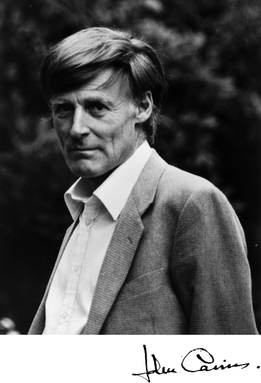John Cairns (biochemist) facts for kids
Quick facts for kids
Professor
John Cairns
|
|
|---|---|
 |
|
| Born |
Hugh John Forster Cairns
21 November 1922 |
| Died | 12 November 2018 (aged 95) |
| Alma mater | University of Oxford B.A., 1943, B.M., 1946, M.D., 1946 |
| Awards | American Academy of Arts and Sciences (1967) Fellow of The Royal Society (1974) MacArthur Foundation Fellow (1981) |
| Scientific career | |
| Fields | Virology Molecular Biology Genetics Cancer Biology |
| Institutions | Cold Spring Harbor Laboratory Harvard University Mill Hill Laboratory |
Hugh John Forster Cairns (FRS) was a British doctor and scientist. He was born on November 21, 1922, and passed away on November 12, 2018. Dr. Cairns made very important discoveries in molecular genetics. This field studies how living things work at a tiny, molecular level. He also did a lot of work in cancer research and public health. His work helped us understand diseases and how to keep people healthy.
John Cairns' Career Journey
John Cairns earned his medical degree from Oxford University. After his studies, he started working as a virologist. This means he studied viruses. He worked at different research places around the world. These included the Walter and Eliza Hall Institute of Medical Research in Melbourne, Australia. He also worked at the Virus Research Institute in Entebbe, Uganda.
Later, he went back to Australia. There, he worked at the School of Microbiology. In the early 1960s, he took a break to do research at the Cold Spring Harbor Laboratory in the United States. He liked it so much that he returned there to be the director from 1963 to 1968. He stayed at Cold Spring Harbor until 1972.
After that, he became the head of the Mill Hill Laboratory. This lab was part of the Imperial Cancer Research Fund. He left Mill Hill in 1980. Then, he became a professor at the Harvard School of Public Health. He retired from his work in 1991.
Discovering DNA's Secrets
In 1963, John Cairns made a huge discovery. He wrote a famous paper about it. The paper was called "The bacterial chromosome and its manner of replication as seen by autoradiography." He used a special method called autoradiography. This method uses radiation to create images of tiny things.
He showed how the DNA of a tiny germ called Escherichia coli (E. coli) copies itself. DNA is like the instruction manual for all living things. He found that the E. coli DNA was a single, long molecule. He saw that it copied itself at a moving spot. This spot was called the "replicating fork." Later, scientists found that DNA actually copies itself in two directions at the same time! This discovery was very important for understanding how life grows and reproduces.
Awards and Books
John Cairns received many honors for his amazing work. In 1974, he was chosen to be a Fellow of The Royal Society. This is a very special group of top scientists in the United Kingdom. In 1981, he received a MacArthur Foundation Fellowship. This award is sometimes called a "genius" fellowship.
He also wrote several books. In 1978, he wrote Cancer: Science and Society. He also wrote Matters of Life and Death in 1997. This book shared his thoughts on public health, molecular biology, and cancer. He also helped edit a collection of historical stories about molecular biology. This book was called Phage and the Origins of Molecular Biology. He worked on it with other famous scientists like James Watson.
See also
- Theta structure

